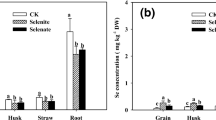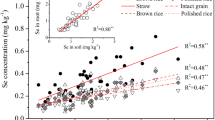Abstract
Paddy soil Cd contamination and the related accumulation risk in rice grains have attracted global attention. The application of selenium and humic substances is considered to be a cost-effective Cd mitigation measure. However, the effect of a combined application of the two materials remains unclear. Therefore, a 2-season pot experiment was conducted, wherein sodium selenite (Se) and biochemical fulvic acid (BFA) were applied alone and together. Paddy soils with two levels of Cd contamination were used. The results indicate that Se application alone considerably decreased the rice grain Cd content by 36.1–48.7% compared to the control rice grain Cd concentration, which was above the food safety limit (0.2 mg kg−1). Although the application of BFA alone decreased the soil pH, it also increased the soil CaCl2 extractable Cd content by 0.2 to 19.3% and had a limited effect on Cd in the rice grains. The combined application of Se and BFA did not affect the soil pH or the CaCl2 extractable Cd, and more effectively reduced the Cd contents of the rice grains by 50.2 to 57.1%, except for the control rice grain Cd content, which was below the limit. The combined application of Se and BFA also inhibited Se accumulation in rice grains, maintaining the Se content at a safe level (0.33–0.58 mg kg−1) compared to Se application alone. The effects of reducing the Cd content of rice grains while safely increasing their Se contents could persist for at least two seasons. Therefore, the combined application of Se and BFA should be recommended to mitigate Cd contamination risks in Cd-contaminated paddy soil.



Similar content being viewed by others
Explore related subjects
Discover the latest articles and news from researchers in related subjects, suggested using machine learning.References
Boruvka L, Drabek O (2004) Heavy metal distribution between fractions of humic substances in heavily polluted soils. Plant, soil Environ 50:339–345
Canellas LP, Olivares FL, Aguiar NO, Jones DL, Nebbioso A, Mazzei P, Piccolo A (2015) Humic and fulvic acids as biostimulants in horticulture. Sci Hortic 196:15–27
Cui JH, Liu TX, Li YD, Li FB (2018) Selenium reduces cadmium uptake into rice suspension cells by regulating the expression of lignin synthesis and cadmium-related genes. Sci Tot Environ 644:602–610
Dhillon K, Dhillon S (2000) Selenium accumulation by sequentially grown wheat and rice as influenced by gypsum application in a seleniferous soil. Plant Soil 227:243–248
Ding YZ, Feng RW, Wang RG, Guo JK, Zheng XQ (2014) A dual effect of Se on Cd toxicity: evidence from plant growth, root morphology and responses of the antioxidative systems of paddy rice. Plant Soil 375:289–301
Duan MM, Wang S, Huang DY, Zhu QH, Liu SL, Zhang Q, Zhu HH, Xu C (2018) Effectiveness of simultaneous applications of lime and zinc/iron foliar sprays to minimize cadmium accumulation in rice. Ecotox Environ Safe 165:510–515
Evangelou MWH, Daghan H, Schaeffer A (2004) The influence of humic acids on the phytoextraction of cadmium from soil. Chemosphere 57:207–213
Feng R, Wei C, Tu S (2013) The roles of selenium in protecting plants against abiotic stresses. Environ Exp Bot 87:58–68
Guo YK, Mao K, Cao HR, Ali W, Lei D, Teng DY, Chang CY, Yang XF, Yang Q, Niazi NK, Feng XB, Zhang H (2021) Exogenous selenium (cadmium) inhibits the absorption and transportation of cadmium (selenium) in rice. Environ Pollut 268:115829
He LL, Huang DY, Zhang Q, Zhu HH, Xu C, Li B, Zhu QH (2021) Meta-analysis of the effects of liming on soil pH and cadmium accumulation in crops. Ecotox Environ Safe 223:112621
He YB, Huang DY, Zhu QH, Wang S, Liu SL, He HB, Zhu HH, Xu C (2017) A three-season field study on the in-situ remediation of Cd-contaminated paddy soil using lime, two industrial by-products, and a low-Cd-accumulation rice cultivar. Ecotox Environ Safe 136:135–141
Hu YN, Chen HF, Tao S (2016) The challenges and solutions for cadmium-contaminated rice in China: a critical review. Environ Int 92-93:515–532
Huang GX, Ding CF, Li YS, Zhang TL, Wang XX (2020) Selenium enhances iron plaque formation by elevating the radial oxygen loss of roots to reduce cadmium accumulation in rice (Oryza sativa L.). J Hazard Mater 398:122860
Huang C, Ragauskas AJ, Xx W, Huang Y, Zhou XL, He J, Huang CX, Lai CH, Li X, Yong Q (2018a) Co-production of bio-ethanol, xylonic acid and slow-release nitrogen fertilizer from low-cost straw pulping solid residue. Bioresource Technol 250:365–373
Huang QQ, Xu YM, Liu YY, Qin X, Huang R, Liang XF (2018b) Selenium application alters soil cadmium bioavailability and reduces its accumulation in rice grown in Cd-contaminated soil. Environ Sci Pollut R 25:31175–31182
Khan KY, Ali B, Cui XQ, Feng Y, Stoffella PJ, Tang L, Yang XE (2017) Effect of humic acid amendment on cadmium bioavailability and accumulation by pak choi (Brassica rapa ssp. chinensis L.) to alleviate dietary toxicity risk. Arch Agron Soil Sci 63:1431–1442
Li B, Zhu QH, Zhang Q, Zhu HH, Huang DY, Su SM, Wang YN, Zeng XB (2021) Cadmium and arsenic availability in soil under submerged incubation: The influence of humic substances on iron speciation. Ecotox Environ Safe 225:112773
Li J, Xu Y (2015) Immobilization of Cd in paddy soil using moisture management and amendment. Environ Sci Pollut Res Int 22:5580–5586
Li N, Gao ZD, Luo DG, Tang X, Chen DF, Hu YH (2007) Selenium level in the environment and the population of Zhoukoudian area, Beijing, China. Sci Tot Environ 381:105–111
Liu N, Jiang ZM, Li X, Liu HY, Li N, Wei SQ (2020) Mitigation of rice cadmium (Cd) accumulation by joint application of organic amendments and selenium (Se) in high-Cd-contaminated soils. Chemosphere 24:125106
Liu TF, Sun L, Meng QC, Yu JH, Weng LS, Li JJ, Deng LH, Zhu QH, Gu XY, Chen CY, Teng S, Xiao GY (2021) Phenotypic and genetic dissection of cadmium accumulation in roots, nodes and grains of rice hybrids. Plant Soil 463:39–53
Liu XW, Zhao ZQ, Duan BH, Hu CX, Zhao XH, Guo ZH (2014) Effect of applied sulphur on the uptake by wheat of selenium applied as selenite. Plant Soil 386:35–45
Lu RK. 1999. Physic-chemistry analysis of soils. China Agricultural Scientific and Technological Press, Beijing (in Chinese).
Rashid I, Murtaza G, Dar AA, Wang ZY (2020) The influence of humic and fulvic acids on Cd bioavailability to wheat cultivars grown on sewage irrigated Cd-contaminated soils. Ecotox Environl Safe 205:111347
Schützendubel A, Schwanz P, Teichmann T, Gross K, Langenfeld-Heyser R, Godbold DL, Polle A (2001) Cadmium-induced changes in antioxidative systems, hydrogen peroxide content, and differentiation in Scots pine roots. Plant Physiol 127:887–898
Shen BB, Wang XM, Zhang Y, Zhang M, Wang K, Xie P, Ji HB (2020) The optimum pH and Eh for simultaneously minimizing bioavailable cadmium and arsenic contents in soils under the organic fertilizer application. Sci Tot Environ 711:135229
Teixeira LS, Pimenta TM, Brito FAL, Malheiros RSP, Arruda RS, Araújo WL, Ribeiro DM (2021) Selenium uptake and grain nutritional quality are affected by nitrogen fertilization in rice (Oryza sativa L.). Plant Cell Rep 40:871–880
Wang X, Tam NFY, Fu S, Ametkhan A, Ouyang Y, Ye ZH (2014) Selenium addition alters mercury uptake, bioavailability in the rhizosphere and root anatomy of rice (Oryza sativa). Ann Bot 114:271–278
Williams PN, Lombi E, Sun GX, Scheckel K, Zhu YG, Feng X, Zhu JM, Carey AM, Adomako E, Lawgali Y, Deacon C, Meharg AA (2009) Selenium characterization in the global rice supply chain. Environ Sci Technol 43:6024–6030
Yao YY, Wang XQ, Yang YC, Shen TL, Wang C, Tang YF, Wang ZH, Xie JZ, Liu L, Hou SM, Gao B, Li YCC, Wan Y (2019) Molecular composition of size-fractionated fulvic acid-like substances extracted from spent cooking liquor and its relationship with biological activity. Environ Sci Technol 53:14752–14760
Yu Y, Wan YN, Camara AY, Li HF (2018) Effects of the addition and aging of humic acid-based amendments on the solubility of Cd in soil solution and its accumulation in rice. Chemosphere 196:303–310
Zhang DR, Chen HR, Xia JL, Nie ZY, Fan XL, Liu HC, Yang HY (2020) Humic acid promotes arsenopyrite bio-oxidation and arsenic immobilization. J Hazard Mater 384:121359
Zhang H, Feng XB, Jiang CX, Li QH, Liu Y, Gu CH, Shang LH, Li P, Lin Y, Larssen T (2014) Understanding the paradox of selenium contamination in mercury mining areas: high soil content and low accumulation in rice. Environ Pollut 188:27–36
Zhang Q, Chen HF, Huang DY, Xu C, Zhu HH, Zhu QH (2019) Water managements limit heavy metal accumulation in rice: dual effects of iron-plaque formation and microbial communities. Sci Tot Environ 687:790–799
Zhang Y, Yang X, Zhang S, Tian Y, Guo W, Wang J (2013) The influence of humic acids on the accumulation of lead (Pb) and cadmium (Cd) in tobacco leaves grown in different soils. J Soil Sci Plant Nut 13:43–53
Zhao FJ, Ma Y, Zhu YG, Tang Z, Mcgrath SP (2015) Soil contamination in China: current status and mitigation strategies. Environ Sci Technol 49:750–759
Zhen S, Shuai H, Xu C, Lv GH, Zhu XD, Zhang Q, Zhu QH, Nunez-Delgado A, Conde-Cid M, Zhou YY, Huang DY (2021) Foliar application of Zn reduces Cd accumulation in grains of late rice by regulating the antioxidant system, enhancing Cd chelation onto cell wall of leaves, and inhibiting Cd translocation in rice. Sci Tot Environ 770:145302
Zhou XB, Yu SH, Wang WH, Chang H, Zhou YX (2014) Effects of application of Selenium in soil on the formation of root surface iron plaque and mercury uptake by rice plants. J Southwest Univ (Nat Sci Ed) 36:91–95 (in Chinese)
Zhu HH, Chen C, Xu C, Zhu QH, Huang DY (2016) Effects of soil acidification and liming on the phytoavailability of cadmium in paddy soils of central subtropical China. Environ Pollut 219:99–106
Zhu QH, Huang DY, Liu SL, Luo ZC, Zhu HH, Zhou B, Lei M, Rao ZX, Cao XL (2012) Assessment of single extraction methods for evaluating the immobilization effect of amendments on cadmium in contaminated acidic paddy soil. Plant Soil Environ 58:98–103
Data availability
The datasets used or analyzed during the current study are available from the corresponding author on reasonable request.
Funding
This study was supported by the Natural Science Foundation of China (41877138), the High Technology Industry S&T Innovation Leading Project of Hunan Province (2020NK2001), and the Earmarked Fund for China Agriculture Research System (CARS-16-E09).
Author information
Authors and Affiliations
Contributions
All authors contributed to the study conception and design. LH: formal analysis, investigation, data curation, writing—original draft. BL: formal analysis, investigation, data curation. DYH: validation, supervision, funding acquisition. QZ: visualization, writing—review and editing. HHZ: writing—review and editing. CX: writing—review and editing. QHZ: conceptualization, methodology, writing—review and editing, funding acquisition.
Corresponding author
Ethics declarations
Ethics approval
Not required.
Consent to participate
The authors declare that we agree to participate in this research.
Consent for publication
The authors confirm:
that the work described has not been published before (except in the form of thesis);
that it is not under consideration for publication elsewhere;
that the manuscript has been approved by the responsible authorities at the institution where the work is carried out.
The authors agree to publication in the journal of Environmental Science and Pollution Research.
Competing interests
The authors declare no competing interests.
Additional information
Responsible Editor: Gangrong Shi
Publisher’s note
Springer Nature remains neutral with regard to jurisdictional claims in published maps and institutional affiliations.
Supplementary Information
ESM 1
(DOCX 41 kb)
Rights and permissions
About this article
Cite this article
He, L., Huang, DY., Liu, B. et al. Combined exogenous selenium and biochemical fulvic acid reduce Cd accumulation in rice. Environ Sci Pollut Res 29, 50059–50069 (2022). https://doi.org/10.1007/s11356-022-19442-1
Received:
Accepted:
Published:
Issue Date:
DOI: https://doi.org/10.1007/s11356-022-19442-1




